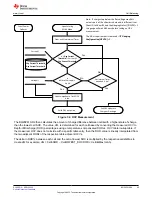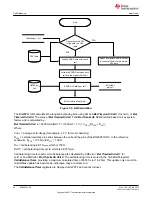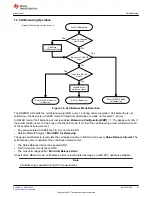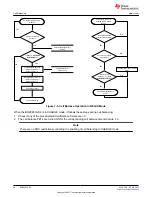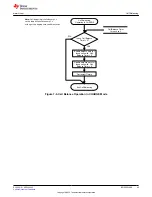
6.1 Introduction
The BQ28Z610-R2 measures individual cell voltages, pack voltage, temperature, and current. It determines
battery state-of-charge by analyzing individual cell voltages when a time exceeding 10 minutes has passed since
the last charge or discharge activity of the battery.
The BQ28Z610-R2 measures charge and discharge activity by monitoring the stable voltage across a small-
value series sense resistor (1 mΩ typ.) between the negative terminal of the cell stack and the negative terminal
of the battery pack. The battery state-of-charge is subsequently adjusted during load or charger application using
the integrated charge passed through the battery. The device is capable of supporting a maximum battery pack
capacity of 32 Ah. See the "Theory and Implementation of Impedance Track Battery Fuel-Gauging Algorithm" in
the
BQ20zxx Product Family Application Report
The default for Impedance Track gauging is
off
. To enable the gauging function, set
Manufacturing
Status[GAUGE_EN]
= 1. The gauging function will be enabled after a reset or a seal command is set.
Alternatively, the MAC command
Gauging()
can be used to turn on and off the gauging function.
Gauging()
takes an immediate effect and the
[GAUGE_EN]
is also updated accordingly.
The
ITStatus1()
,
ITStatus2()
, and
ITStatus3()
commands return various gauging related information, which is
useful for problem analysis.
6.2 Impedance Track Configuration
Load Mode
During normal operation, the battery-impedance profile compensation of the Impedance
Track algorithm can provide more accurate full-charge and remaining state-of-charge
information if the typical load type is known. The two selectable options are constant current
(
Load Mode
= 0) and constant power (
Load Mode
= 1).
Load Select
To compensate for the I × R drop near the end of discharge, the BQ28Z610-R2 must be
configured for whatever current (or power) will flow in the future. While it cannot be exactly
known, the BQ28Z610-R2 can use load history, such as the average current of the present
discharge to make a sufficiently accurate prediction.
The BQ28Z610-R2 can be configured to use several methods of this prediction by setting
the
Load Select
value. Because this estimate has only a second-order effect on remaining
capacity accuracy, different measurement-based methods (methods 0 to 3, and method 7)
result in only minor differences in accuracy. However, methods 4–6, where an estimate is
arbitrarily assigned by the user, can result in a significant error if a fixed estimate is far from
the actual load. For highly variable loads, selection 7 provides the most balanced estimate
and is preferable.
Constant Current
(
Load Mode
= 0)
Constant Power
(
Load Mode
= 1)
0 =
Avg I Last Run
Avg P Last Run
1 = Present average discharge current
Present average discharge power
2 =
Current()
Current()
×
Voltage()
3 =
AverageCurrent()
AverageCurrent()
× average
Voltage()
Chapter 6
Gauging
Gauging
SLUUCO0 – APRIL 2022
BQ28Z610-R2
35
Copyright © 2022 Texas Instruments Incorporated

























